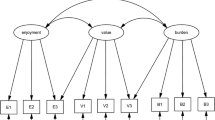Abstract
Survey questions worded with the verb ‘forbid’ prove not to elicit opposite answers to equivalent questions worded with the verb ‘allow’ (Rugg 1941). Although ‘forbid’ and ‘allow’ are generally considered each other’s counterparts, respondents rather answer ‘no, not forbid’ than ‘yes, allow’. In order to find out which question is a more valid measure of the underlying attitude, this asymmetry in the answers has to be explained. Experiments show that the asymmetry arises because respondents translate similar attitudes differently into the answering options to forbid/allow questions are equally valid, but the way the attitudes are expressed on the answering scale differs due to the use of ‘forbid’ or ‘allow’. How does this translation process work? The leading hypothesis in forbid/allow research predicts that respondents holding moderate opinions feel that ‘yes forbid’ and ‘yes allow’ are very extreme, causing moderate respondents to prefer answering ‘not forbid’, or ‘not allow’. This article presents the results of 10 experiments investigating the meanings of the answering options to forbid/allow questions. Extreme connotations are shown to only provide part of the explanation for the occurrence of the forbid/allow asymmetry. In order to describe the answering process for forbid/allow questions, well-definedness of meanings proves to be an important additional factor. The meanings of answering options to allow questions are ill-defined compared of those to forbid questions, which causes allow questions to be less homogeneous measures of the underlying attitude than forbid questions.
Similar content being viewed by others
References
J. Billiet (1989) Wat te doen? Beschouwingen over het nut van pasklare voorschriften voor het ontwerpen van survey-vragen [What to do? Reflections on the use of ready-made advice on the design of survey questions] J. Zouwen ParticleVander W. Dijkstra (Eds) Sociaal wetenschappelijk onderzoek met vragenlijsten. Methoden, knelpunten, oplossingen VU-Uitgeverij Amsterdam 35–52
G. F. Bishop H.-J. Hippler N. Schwarz F. Strack (1988) A comparison of response effects in self-administered and telephone surveys R. M. Groves P. Biemer L. Lyberg J. Massey W. Nicholls J. Waksberg (Eds) Telephone Survey Methodology Wiley New York 273–282
A. V. Cicourel (1982) ArticleTitleInterviews, surveys and the problem of ecological validity The American Sociologist 17 11–20
H.-J. Hippler N. Schwarz (1986) ArticleTitleNot forbidding isn’t allowing: The cognitive basis of the forbid/allow asymmetry Public Opinion Quarterly 50 87–96 Occurrence Handle10.1086/268961
B. C. Holleman (1999a) ArticleTitleWording effects in survey research. Using meta-anlaysis to explain the forbid/allow asymmetry Journal of Quantitative Linguistics 6 29–40 Occurrence Handle10.1076/jqul.6.1.29.4145
B. C. Holleman (1999) ArticleTitleThe nature of the forbid/allow asymmetry. Two correlational studies Sociological Methods & Research 28 IssueID2 209–244
B. C. Holleman (2000) The Forbid/Allow Asymmetry On the Cognitive Mechanisms Underlying Wording Effects in Surveys Rodopi Amsterdam/Atlanta
H. Houtkoop H. Bergh Particlevan den (2000) ArticleTitleEffects of introductions in large-scale telephone survey interviews Sociological Methods & Research 28 IssueID3 281–300
J. B. Jobe D. J. Mingay (1991) ArticleTitleCognition and survey measurement: History and overview Applied Cognitive Psychology 5 IssueID1 175–192
K.G. Jöreskog (1971) ArticleTitleStatistical analysis of sets of congeneric tests Psychometrika 36 109–133
J. A. Krosnick H. Schuman (1988) ArticleTitleAttitude intensity, importance, and certainty and susceptibility to response effects Journal of Personality and Social Psychology 54 IssueID6 940–952 Occurrence Handle10.1037/0022-3514.54.6.940
N. Molenaar (1982) Response effects of “formal” characteristics of questions W. Dijkstra J. Zouwen ParticleVander (Eds) Response Behaviour in the Survey Interview Academic Press London 49–89
K.-H. Reuband (2000) ArticleTitle“Erlauben” vs. “nicht erlauben” oder “verbieten”? wie sich unterschiedliche Frage-Alternatieve auf das Antwortverhalten auswirken ZUMA-Information 48 42–55
D. Rugg (1941) ArticleTitleExperiments in wording questions II Public Opinion Quarterly 5 91–92 Occurrence Handle10.1086/265467
Schuman, H. & Presser, S. (1981/1996). Questions and Answers in Attitude Surveys. Experiments on Question Form, Wording, and Context. Thousand Oaks, CA: Sage Publications (Originally published in New York: Academic Press).
S. Sudman N. M. Bradburn N. Schwarz (1996) Thinking About Answers. The Application of Cognitive Processes to Survey Methodology Jossey-Bass Publishers San Francisco
L. Talmy (1988) ArticleTitleForce dynamics in language and cognition Cognitive Science 12 49–100 Occurrence Handle10.1016/0364-0213(88)90008-0
Tourangeau, R., Rips, L. J. & Rasinski, K. (2000). The Psychology of Survey Response. Cambridge University Press.
R. Tourangeau K. Rasinski (1988) ArticleTitleCognitive processes underlying context effects in attitude measurement Psychological Bulletin 103 299–314 Occurrence Handle10.1037/0033-2909.103.3.299
L. Waterplas J. Billiet G. Loosveldt (1988) ArticleTitleDe verbieden versus niet toelaten asymmetrie Een stabiel formuleringseffect in survey-onderzoek? [The forbid/allow asymmetry A stable wording effect in survey research?] Mens en Maatschappij. 63 399–415
Author information
Authors and Affiliations
Corresponding author
Rights and permissions
About this article
Cite this article
Holleman, B.C. The Meanings of ‘Yes’ and ‘No’. An Explanation for the Forbid/Allow Asymmetry. Qual Quant 40, 1–38 (2006). https://doi.org/10.1007/s11135-005-4479-6
Issue Date:
DOI: https://doi.org/10.1007/s11135-005-4479-6




